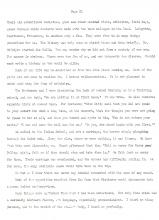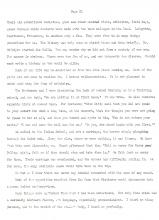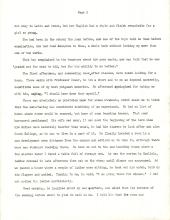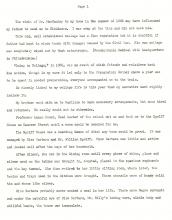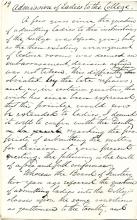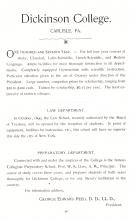"I was a Co-ed": The Lack of Early Women's Societies
In her 1951 memoir, Elizabeth A. Low remembers there being few early women's organizations at Dickinson College. She explained, "You may may wonder why we did not form a soceity of our own. The answer is obvious. There were too few of us, and our interests too diverse. Should each write a history not two would be alike."
"I was a Co-ed": Male Students Feared that Dickinson Would Become a Women's Institution
In her 1951 memoir, Elizabeth A. Low discusses the reaction of many male students to the institution of coeducation. According to Low, many male students rescented early female students. Low explains, "So far as I know there was never any scandal connected with the name of any co-ed. Much of the opposition resulted from the fear that Dickinson would degenerate into a young ladies seminary-type."
"I was a Co-ed": Housing for Early Female Students
Upon her arrival at Dickinson College in 1886, Elizabeth Low was shocked to find that no housing arrangements had been made for female students. Unlike their male counterparts, early female Dickinsonians were not permitted to live in dorms on campus. Moreover, the school had not found housing in town for the young women.
"I was a Coed": The Decision to Go to Dickinson
During the summer of 1886, Elizabeth A. Low's family decided to send her to Dickinson College. Low wrote, "The visit of Dr. MacCauley [sic] to my home in the summer of 1886 may have influenced my father to send me to Dickinson. I was away at the time and did not meet him." Low pursued an education at Dickinson College, graduating in 1891.
President's Report to the Board of Trustees on the Implementation of Coeducation
On June 26th, 1883, President McCauley presented his report on the 1883 school year, announcing the faculty desicion to admit women to Dickinson College. He explained that it was, "Resolved that the faculty recommend to the Board of Trustees that ladies be admitted to the classes of the College upon the same conditions as gentlemen." The following year, women were admitted to the sophomore and freshman classes.
Faculty Discuss the Admission of Women, 1883
On May 24, 1883, the faculty discussed whether or not female students should be admitted to Dickinson College. Referencing the discussion regarding coeducation that took place two years earlier, the faculty decided that the conditions of the college grounds were now suitable for female students. Thus, the faculty decided to "recommend to the Board of Trustees that women be admitted to the classes of the college on the same conditions of men." Nearly all the faculty, with the exception of Professor Harman, voted in favor of coeducation.
Advertisement for Dickinson College in the 1890 Microcosm
The 1890 Microcosm shows an advertisement for Dickinson College and the services it offers. In the category of the Preparartory Department, the advertisement mentions, "The course of study covers three years, and prepares students of both sexes thoroughly for Dickinson College, or for any literary institution in the country." This shows the college's acceptance of co-education by advertising directly for new students of both sexes.


